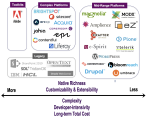What makes your project successful in the real world
There are many ways to measure success of an information management project. Project leaders typically want to help their colleagues, but how do they know they're successful? System adoption is critical here.
So here's a tip. Your project team can mitigate the risk of alienating end-users by separating notions of "education" and "training." Training is something that cannot take place until a system is ready to use – usually later in the project. "Education" should begin as early as possible, and conducted in parallel with or before a technology implementation.
Future users of any new system will almost always need education on key concepts. In a Web CMS context, for example, key concepts would include everything from the basic, "what is content?" and "what are templates?" to explaining metadata and the impact it has on where and when content appears on the site. Many of you reading this may think that everyone knows these basics, but trust me, they do not.
Alan and I recently helped a client create an education program for a major web content management overhaul being conducted in conjunction with a major front-end redesign. This project marked a fundamental change in the way this enterprise manages and publishes content. Like many major CMS projects, business processes throughout the organization were substantially impacted. With more than a thousand stakeholders and users across seventy different countries, the project risked getting seen internally as simply just another in a long series of front-end redesigns that didn't really impact their daily work.
In a hands-on workshop that was purposefully a bit of fun (do NOT expect 1000+ people to get energized and ready to change over just another PowerPoint presentation), we were able to simulate how the current way of working was not sustainable, and showed the power of a new way of working. This education (remember: it wasn't system training) became the centerpiece of the company's global change management effort. Users were engaged with the project as the actual development was on-going. A rarity in these types of projects, we found end users thrilled to get included in the process, and excited to see how they could be a part of the company's fundamental change.
Projects that skimp on education and training usually do not launch smoothly. Users are inadequately prepared for their "new" jobs, and often take out their frustrations on the new system. Sometimes this leads to complete lack of adoption, or people using the system in ways it was never intended. While most project leaders tend to focus on budget and schedule, user satisfaction and their ability to adequately perform their jobs is the most meaningful metric for determining success or failure.
Focus your attention there.








